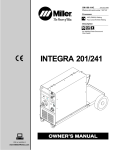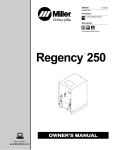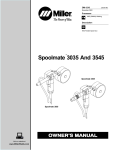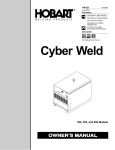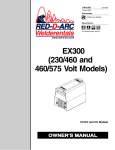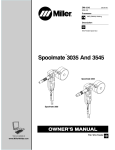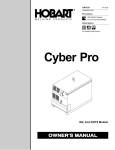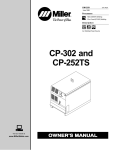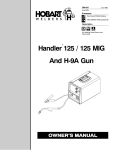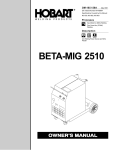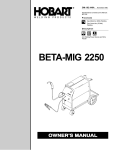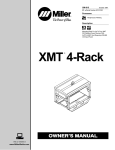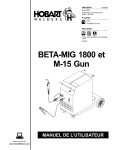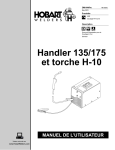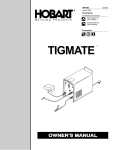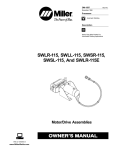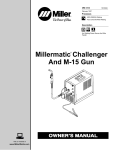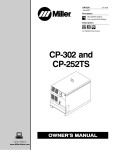Download Miller Electric Spoolmate 250 User's Manual
Transcript
OM-1215 March 2000 Processes MIG (GMAW) Welding Description Wire Feeder Spool Gun Spoolmate 250 Visit our website at www.MillerWelds.com 199 381 From Miller to You Thank you and congratulations on choosing Miller. Now you can get the job done and get it done right. We know you don’t have time to do it any other way. That’s why when Niels Miller first started building arc welders in 1929, he made sure his products offered long-lasting value and superior quality. Like you, his customers couldn’t afford anything less. Miller products had to be more than the best they could be. They had to be the best you could buy. Today, the people that build and sell Miller products continue the tradition. They’re just as committed to providing equipment and service that meets the high standards of quality and value established in 1929. This Owner’s Manual is designed to help you get the most out of your Miller products. Please take time to read the Safety precautions. They will help you protect yourself against potential hazards on the worksite. We’ve made installation and operation quick and easy. With Miller you can count on years of reliable service with proper maintenance. And if for some reason the unit needs repair, there’s a Troubleshooting section that will help you Miller is the first welding figure out what the problem is. The parts list equipment manufacturer in will then help you to decide which exact part the U.S.A. to be registered to the ISO 9001 Quality System you may need to fix the problem. Warranty and Standard. service information for your particular model are also provided. Miller Electric manufactures a full line of welders and welding related equipment. For information on other quality Miller products, contact your local Miller distributor to receive the latest full line catalog or individual catalog sheets. To locate your nearest distributor or service agency call 1-800-4-A-Miller, or visit us at www.MillerWelds.com on the web. Working as hard as you do – every power source from Miller is backed by the most hassle-free warranty in the business. Miller offers a Technical Manual which provides more detailed service and parts information for your unit. To obtain a Technical Manual, contact your local distributor. Your distributor can also supply you with Welding Process Manuals such as SMAW, GTAW, GMAW, and GMAW-P. TABLE OF CONTENTS WARNING This product, when used for welding or cutting, produces fumes or gases which contain chemicals known to the State of California to cause birth defects and, in some cases, cancer. (California Health & Safety Code Section 25249.5 et seq.) OM-1215 SECTION 1 – SAFETY PRECAUTIONS - READ BEFORE USING . . . . . . . . . . . . . . . . . . . . . . . . . . . . 1-1. Symbol Usage . . . . . . . . . . . . . . . . . . . . . . . . . . . . . . . . . . . . . . . . . . . . . . . . . . . . . . . . . . . . . . . . 1-2. Arc Welding Hazards . . . . . . . . . . . . . . . . . . . . . . . . . . . . . . . . . . . . . . . . . . . . . . . . . . . . . . . . . . 1-3. Additional Symbols For Installation, Operation, And Maintenance . . . . . . . . . . . . . . . . . . . . . 1-4. Principal Safety Standards . . . . . . . . . . . . . . . . . . . . . . . . . . . . . . . . . . . . . . . . . . . . . . . . . . . . . 1-5. EMF Information . . . . . . . . . . . . . . . . . . . . . . . . . . . . . . . . . . . . . . . . . . . . . . . . . . . . . . . . . . . . . . SECTION 1 – CONSIGNES DE SECURITE – LIRE AVANT UTILISATION . . . . . . . . . . . . . . . . . . . . . 1-1. Signification des symboles . . . . . . . . . . . . . . . . . . . . . . . . . . . . . . . . . . . . . . . . . . . . . . . . . . . . . 1-2. Dangers relatifs au soudage à l’arc . . . . . . . . . . . . . . . . . . . . . . . . . . . . . . . . . . . . . . . . . . . . . . 1-3. Dangers supplémentaires en relation avec l’installation, le fonctionnement et la maintenance . . . . . . . . . . . . . . . . . . . . . . . . . . . . . . . . . . . . . . . . . . . . . . . . . . . . . . . . . . . . . 1-4. Principales normes de sécurité . . . . . . . . . . . . . . . . . . . . . . . . . . . . . . . . . . . . . . . . . . . . . . . . . . 1-5. Information sur les champs électromagnétiques . . . . . . . . . . . . . . . . . . . . . . . . . . . . . . . . . . . . SECTION 2 – INSTALLATION . . . . . . . . . . . . . . . . . . . . . . . . . . . . . . . . . . . . . . . . . . . . . . . . . . . . . . . . . . . 2-1. Specifications . . . . . . . . . . . . . . . . . . . . . . . . . . . . . . . . . . . . . . . . . . . . . . . . . . . . . . . . . . . . . . . . 2-2. Installing Spoolgun Switch In Welding Power Source (If Connecting To Millermatic 185 Prior To Serial No. KH376829 Unit Requires Installation Of Field Kit 186871) . . . . . . . . . . . . 2-3. Connecting Spoolgun To Welding Power Source . . . . . . . . . . . . . . . . . . . . . . . . . . . . . . . . . . . 2-4. Installing Wire Spool And Threading Welding Wire . . . . . . . . . . . . . . . . . . . . . . . . . . . . . . . . . . SECTION 3 – OPERATION . . . . . . . . . . . . . . . . . . . . . . . . . . . . . . . . . . . . . . . . . . . . . . . . . . . . . . . . . . . . . 3-1. Controls . . . . . . . . . . . . . . . . . . . . . . . . . . . . . . . . . . . . . . . . . . . . . . . . . . . . . . . . . . . . . . . . . . . . . SECTION 4 – MAINTENANCE & TROUBLESHOOTING . . . . . . . . . . . . . . . . . . . . . . . . . . . . . . . . . . . . 4-1. Routine Maintenance . . . . . . . . . . . . . . . . . . . . . . . . . . . . . . . . . . . . . . . . . . . . . . . . . . . . . . . . . . 4-2. Changing Drive Rolls . . . . . . . . . . . . . . . . . . . . . . . . . . . . . . . . . . . . . . . . . . . . . . . . . . . . . . . . . . 4-3. Changing Liner . . . . . . . . . . . . . . . . . . . . . . . . . . . . . . . . . . . . . . . . . . . . . . . . . . . . . . . . . . . . . . . 4-4. Troubleshooting . . . . . . . . . . . . . . . . . . . . . . . . . . . . . . . . . . . . . . . . . . . . . . . . . . . . . . . . . . . . . . SECTION 5 – ELECTRICAL DIAGRAMS . . . . . . . . . . . . . . . . . . . . . . . . . . . . . . . . . . . . . . . . . . . . . . . . . SECTION 6 – PARTS LIST . . . . . . . . . . . . . . . . . . . . . . . . . . . . . . . . . . . . . . . . . . . . . . . . . . . . . . . . . . . . . . OPTIONS AND ACCESSORIES WARRANTY 1 1 1 3 3 4 5 5 5 7 8 8 9 9 9 10 11 12 12 12 12 13 14 14 15 16 SECTION 1 – SAFETY PRECAUTIONS - READ BEFORE USING som _nd_4/98 1-1. Symbol Usage Means Warning! Watch Out! There are possible hazards with this procedure! The possible hazards are shown in the adjoining symbols. Y Marks a special safety message. . Means “Note”; not safety related. This group of symbols means Warning! Watch Out! possible ELECTRIC SHOCK, MOVING PARTS, and HOT PARTS hazards. Consult symbols and related instructions below for necessary actions to avoid the hazards. 1-2. Arc Welding Hazards Y The symbols shown below are used throughout this manual to call attention to and identify possible hazards. When you see the symbol, watch out, and follow the related instructions to avoid the hazard. The safety information given below is only a summary of the more complete safety information found in the Safety Standards listed in Section 1-4. Read and follow all Safety Standards. D If earth grounding of the workpiece is required, ground it directly with a separate cable. Y Only qualified persons should install, operate, maintain, and repair this unit. D Wear a safety harness if working above floor level. D Keep all panels and covers securely in place. Y During operation, keep everybody, especially children, away. D Clamp work cable with good metal-to-metal contact to workpiece or worktable as near the weld as practical. ELECTRIC SHOCK can kill. Touching live electrical parts can cause fatal shocks or severe burns. The electrode and work circuit is electrically live whenever the output is on. The input power circuit and machine internal circuits are also live when power is on. In semiautomatic or automatic wire welding, the wire, wire reel, drive roll housing, and all metal parts touching the welding wire are electrically live. Incorrectly installed or improperly grounded equipment is a hazard. D Do not touch electrode if you are in contact with the work, ground, or another electrode from a different machine. D Use only well-maintained equipment. Repair or replace damaged parts at once. Maintain unit according to manual. D Insulate work clamp when not connected to workpiece to prevent contact with any metal object. D Do not connect more than one electrode or work cable to any single weld output terminal. SIGNIFICANT DC VOLTAGE exists after removal of input power on inverters. D Turn Off inverter, disconnect input power, and discharge input capacitors according to instructions in Maintenance Section before touching any parts. D Do not touch live electrical parts. D Wear dry, hole-free insulating gloves and body protection. D Insulate yourself from work and ground using dry insulating mats or covers big enough to prevent any physical contact with the work or ground. D Do not use AC output in damp areas, if movement is confined, or if there is a danger of falling. D Use AC output ONLY if required for the welding process. D If AC output is required, use remote output control if present on unit. D Disconnect input power or stop engine before installing or servicing this equipment. Lockout/tagout input power according to OSHA 29 CFR 1910.147 (see Safety Standards). D Properly install and ground this equipment according to its Owner’s Manual and national, state, and local codes. D Keep your head out of the fumes. Do not breathe the fumes. D Always verify the supply ground – check and be sure that input power cord ground wire is properly connected to ground terminal in disconnect box or that cord plug is connected to a properly grounded receptacle outlet. D When making input connections, attach proper grounding conductor first – double-check connections. D Frequently inspect input power cord for damage or bare wiring – replace cord immediately if damaged – bare wiring can kill. D Turn off all equipment when not in use. D Do not use worn, damaged, undersized, or poorly spliced cables. D Do not weld in locations near degreasing, cleaning, or spraying operations. The heat and rays of the arc can react with vapors to form highly toxic and irritating gases. D Do not drape cables over your body. FUMES AND GASES can be hazardous. Welding produces fumes and gases. Breathing these fumes and gases can be hazardous to your health. D If inside, ventilate the area and/or use exhaust at the arc to remove welding fumes and gases. D If ventilation is poor, use an approved air-supplied respirator. D Read the Material Safety Data Sheets (MSDSs) and the manufacturer’s instructions for metals, consumables, coatings, cleaners, and degreasers. D Work in a confined space only if it is well ventilated, or while wearing an air-supplied respirator. Always have a trained watchperson nearby. Welding fumes and gases can displace air and lower the oxygen level causing injury or death. Be sure the breathing air is safe. D Do not weld on coated metals, such as galvanized, lead, or cadmium plated steel, unless the coating is removed from the weld area, the area is well ventilated, and if necessary, while wearing an air-supplied respirator. The coatings and any metals containing these elements can give off toxic fumes if welded. OM-1215 Page 1 ARC RAYS can burn eyes and skin. Arc rays from the welding process produce intense visible and invisible (ultraviolet and infrared) rays that can burn eyes and skin. Sparks fly off from the weld. D Wear a welding helmet fitted with a proper shade of filter to protect your face and eyes when welding or watching (see ANSI Z49.1 and Z87.1 listed in Safety Standards). D Wear approved safety glasses with side shields under your helmet. D Use protective screens or barriers to protect others from flash and glare; warn others not to watch the arc. D Wear protective clothing made from durable, flame-resistant material (leather and wool) and foot protection. BUILDUP OF GAS can injure or kill. D Shut off shielding gas supply when not in use. D Always ventilate confined spaces or use approved air-supplied respirator. HOT PARTS can cause severe burns. D Do not touch hot parts bare handed. D Allow cooling period before working on gun or torch. MAGNETIC FIELDS can affect pacemakers. WELDING can cause fire or explosion. Welding on closed containers, such as tanks, drums, or pipes, can cause them to blow up. Sparks can fly off from the welding arc. The flying sparks, hot workpiece, and hot equipment can cause fires and burns. Accidental contact of electrode to metal objects can cause sparks, explosion, overheating, or fire. Check and be sure the area is safe before doing any welding. D Protect yourself and others from flying sparks and hot metal. D Do not weld where flying sparks can strike flammable material. D Remove all flammables within 35 ft (10.7 m) of the welding arc. If this is not possible, tightly cover them with approved covers. D Be alert that welding sparks and hot materials from welding can easily go through small cracks and openings to adjacent areas. D Watch for fire, and keep a fire extinguisher nearby. D Be aware that welding on a ceiling, floor, bulkhead, or partition can cause fire on the hidden side. D Do not weld on closed containers such as tanks, drums, or pipes, unless they are properly prepared according to AWS F4.1 (see Safety Standards). D Connect work cable to the work as close to the welding area as practical to prevent welding current from traveling long, possibly unknown paths and causing electric shock and fire hazards. D Do not use welder to thaw frozen pipes. D Remove stick electrode from holder or cut off welding wire at contact tip when not in use. D Wear oil-free protective garments such as leather gloves, heavy shirt, cuffless trousers, high shoes, and a cap. D Remove any combustibles, such as a butane lighter or matches, from your person before doing any welding. FLYING METAL can injure eyes. D Welding, chipping, wire brushing, and grinding cause sparks and flying metal. As welds cool, they can throw off slag. D Wear approved safety glasses with side shields even under your welding helmet. OM-1215 Page 2 D Pacemaker wearers keep away. D Wearers should consult their doctor before going near arc welding, gouging, or spot welding operations. NOISE can damage hearing. Noise from some processes or equipment can damage hearing. D Wear approved ear protection if noise level is high. CYLINDERS can explode if damaged. Shielding gas cylinders contain gas under high pressure. If damaged, a cylinder can explode. Since gas cylinders are normally part of the welding process, be sure to treat them carefully. D Protect compressed gas cylinders from excessive heat, mechanical shocks, slag, open flames, sparks, and arcs. D Install cylinders in an upright position by securing to a stationary support or cylinder rack to prevent falling or tipping. D Keep cylinders away from any welding or other electrical circuits. D Never drape a welding torch over a gas cylinder. D Never allow a welding electrode to touch any cylinder. D Never weld on a pressurized cylinder – explosion will result. D Use only correct shielding gas cylinders, regulators, hoses, and fittings designed for the specific application; maintain them and associated parts in good condition. D Turn face away from valve outlet when opening cylinder valve. D Keep protective cap in place over valve except when cylinder is in use or connected for use. D Read and follow instructions on compressed gas cylinders, associated equipment, and CGA publication P-1 listed in Safety Standards. 1-3. Additional Symbols For Installation, Operation, And Maintenance FIRE OR EXPLOSION hazard. MOVING PARTS can cause injury. D Do not install or place unit on, over, or near combustible surfaces. D Do not install unit near flammables. D Do not overload building wiring – be sure power supply system is properly sized, rated, and protected to handle this unit. D Keep away from moving parts such as fans. D Keep all doors, panels, covers, and guards closed and securely in place. FALLING UNIT can cause injury. H.F. RADIATION can cause interference. D Use lifting eye to lift unit only, NOT running gear, gas cylinders, or any other accessories. D Use equipment of adequate capacity to lift and support unit. D If using lift forks to move unit, be sure forks are long enough to extend beyond opposite side of unit. D OVERUSE can cause OVERHEATING D D Allow cooling period; follow rated duty cycle. D Reduce current or reduce duty cycle before starting to weld again. D Do not block or filter airflow to unit. D D D High-frequency (H.F.) can interfere with radio navigation, safety services, computers, and communications equipment. D Have only qualified persons familiar with electronic equipment perform this installation. The user is responsible for having a qualified electrician promptly correct any interference problem resulting from the installation. If notified by the FCC about interference, stop using the equipment at once. Have the installation regularly checked and maintained. Keep high-frequency source doors and panels tightly shut, keep spark gaps at correct setting, and use grounding and shielding to minimize the possibility of interference. STATIC (ESD) can damage PC boards. D Put on grounded wrist strap BEFORE handling boards or parts. D Use proper static-proof bags and boxes to store, move, or ship PC boards. ARC WELDING can cause interference. MOVING PARTS can cause injury. D Keep away from moving parts. D Keep away from pinch points such as drive rolls. D D WELDING WIRE can cause injury. D Do not press gun trigger until instructed to do so. D Do not point gun toward any part of the body, other people, or any metal when threading welding wire. D D D Electromagnetic energy can interfere with sensitive electronic equipment such as computers and computer-driven equipment such as robots. D Be sure all equipment in the welding area is electromagnetically compatible. To reduce possible interference, keep weld cables as short as possible, close together, and down low, such as on the floor. Locate welding operation 100 meters from any sensitive electronic equipment. Be sure this welding machine is installed and grounded according to this manual. If interference still occurs, the user must take extra measures such as moving the welding machine, using shielded cables, using line filters, or shielding the work area. 1-4. Principal Safety Standards Safety in Welding and Cutting, ANSI Standard Z49.1, from American Welding Society, 550 N.W. LeJeune Rd, Miami FL 33126 Safety and Health Standards, OSHA 29 CFR 1910, from Superintendent of Documents, U.S. Government Printing Office, Washington, D.C. 20402. Recommended Safe Practices for the Preparation for Welding and Cutting of Containers That Have Held Hazardous Substances, American Welding Society Standard AWS F4.1, from American Welding Society, 550 N.W. LeJeune Rd, Miami, FL 33126 National Electrical Code, NFPA Standard 70, from National Fire Protection Association, Batterymarch Park, Quincy, MA 02269. Safe Handling of Compressed Gases in Cylinders, CGA Pamphlet P-1, from Compressed Gas Association, 1235 Jefferson Davis Highway, Suite 501, Arlington, VA 22202. Code for Safety in Welding and Cutting, CSA Standard W117.2, from Canadian Standards Association, Standards Sales, 178 Rexdale Boulevard, Rexdale, Ontario, Canada M9W 1R3. Safe Practices For Occupation And Educational Eye And Face Protection, ANSI Standard Z87.1, from American National Standards Institute, 1430 Broadway, New York, NY 10018. Cutting And Welding Processes, NFPA Standard 51B, from National Fire Protection Association, Batterymarch Park, Quincy, MA 02269. OM-1215 Page 3 1-5. EMF Information Considerations About Welding And The Effects Of Low Frequency Electric And Magnetic Fields Welding current, as it flows through welding cables, will cause electromagnetic fields. There has been and still is some concern about such fields. However, after examining more than 500 studies spanning 17 years of research, a special blue ribbon committee of the National Research Council concluded that: “The body of evidence, in the committee’s judgment, has not demonstrated that exposure to powerfrequency electric and magnetic fields is a human-health hazard.” However, studies are still going forth and evidence continues to be examined. Until the final conclusions of the research are reached, you may wish to minimize your exposure to electromagnetic fields when welding or cutting. To reduce magnetic fields in the workplace, use the following procedures: OM-1215 Page 4 1. Keep cables close together by twisting or taping them. 2. Arrange cables to one side and away from the operator. 3. Do not coil or drape cables around your body. 4. Keep welding power source and cables as far away from operator as practical. 5. Connect work clamp to workpiece as close to the weld as possible. About Pacemakers: Pacemaker wearers consult your doctor first. If cleared by your doctor, then following the above procedures is recommended. SECTION 1 – CONSIGNES DE SECURITE – LIRE AVANT UTILISATION som _nd_fre 4/98 1-1. Signification des symboles Signifie Mise en garde ! Soyez vigilant ! Cette procédure présente des risques de danger ! Ceux-ci sont identifiés par des symboles adjacents aux directives. Y Identifie un message de sécurité particulier. . Signifie NOTA ; n’est pas relatif à la sécurité. Ce groupe de symboles signifie Mise en garde ! Soyez vigilant ! Il y a des risques de danger reliés aux CHOCS ÉLECTRIQUES, aux PIÈCES EN MOUVEMENT et aux PIÈCES CHAUDES. Reportez-vous aux symboles et aux directives ci-dessous afin de connaître les mesures à prendre pour éviter tout danger. 1-2. Dangers relatifs au soudage à l’arc Y Les symboles présentés ci-après sont utilisés tout au long du présent manuel pour attirer votre attention et identifier les risques de danger. Lorsque vous voyez un symbole, soyez vigilant et suivez les directives mentionnées afin d’éviter tout danger. Les consignes de sécurité présentées ci-après ne font que résumer l’information contenue dans les normes de sécurité énumérées à la section 1-4. Veuillez lire et respecter toutes ces normes de sécurité. Y L’installation, l’utilisation, l’entretien et les réparations ne doivent être confiés qu’à des personnes qualifiées. Y Au cours de l’utilisation, tenir toute personne à l’écart et plus particulièrement les enfants. D N’utiliser qu’un matériel en bon état. Réparer ou remplacer sur-lechamp les pièces endommagées. Entretenir l’appareil conformément à ce manuel. D Porter un harnais de sécurité quand on travaille en hauteur. D Maintenir solidement en place tous les panneaux et capots. D Fixer le câble de retour de façon à obtenir un bon contact métal-métal avec la pièce à souder ou la table de travail, le plus près possible de la soudure. D Isoler la pince de masse quand pas mis à la pièce pour éviter le contact avec tout objet métallique. UN CHOC ÉLECTRIQUE peut tuer. Un simple contact avec des pièces électriques peut provoquer une électrocution ou des blessures graves. L’électrode et le circuit de soudage sont sous tension dès que l’appareil est sur ON. Le circuit d’entrée et les circuits internes de l’appareil sont également sous tension à ce moment-là. En soudage semi-automatique ou automatique, le fil, le dévidoir, le logement des galets d’entraînement et les pièces métalliques en contact avec le fil de soudage sont sous tension. Des matériels mal installés ou mal mis à la terre présentent un danger. Il y a DU COURANT CONTINU IMPORTANT dans les convertisseurs après la suppression de l’alimentation électrique. D Arrêter les convertisseurs, débrancher le courant électrique, et décharger les condensateurs d’alimentation selon les instructions indiquées dans la partie entretien avant de toucher les pièces. D Ne jamais toucher les pièces électriques sous tension. D Porter des gants et des vêtements de protection secs ne comportant pas de trous. D S’isoler de la pièce et de la terre au moyen de tapis ou d’autres moyens isolants suffisamment grands pour empêcher le contact physique éventuel avec la pièce ou la terre. D D D Ne pas se servir de source électrique àcourant électrique dans les zones humides, dans les endroits confinés ou là où on risque de tomber. Se servir d’une source électrique àcourant électrique UNIQUEMENT si le procédé de soudage le demande. Si l’utilisation d’une source électrique àcourant électrique s’avère nécessaire, se servir de la fonction de télécommande si l’appareil en est équipé. D Couper l’alimentation ou arrêter le moteur avant de procéder à l’installation, à la réparation ou à l’entretien de l’appareil. Déverrouiller l’alimentation selon la norme OSHA 29 CFR 1910.147 (voir normes de sécurité). D Installer et mettre à la terre correctement cet appareil conformément à son manuel d’utilisation et aux codes nationaux, provinciaux et municipaux. D Toujours vérifier la terre du cordon d’alimentation – Vérifier et s’assurer que le fil de terre du cordon d’alimentation est bien raccordé à la borne de terre du sectionneur ou que la fiche du cordon est raccordée à une prise correctement mise à la terre. D En effectuant les raccordements d’entrée fixer d’abord le conducteur de mise à la terre approprié et contre-vérifier les connexions. D Vérifier fréquemment le cordon d’alimentation pour voir s’il n’est pas endommagé ou dénudé – remplacer le cordon immédiatement s’il est endommagé – un câble dénudé peut provoquer une électrocution. D Mettre l’appareil hors tension quand on ne l’utilise pas. D Ne pas utiliser des câbles usés, endommagés, de grosseur insuffisante ou mal épissés. D Ne pas enrouler les câbles autour du corps. D Si la pièce soudée doit être mise à la terre, le faire directement avec un câble distinct. D Ne pas toucher l’électrode quand on est en contact avec la pièce, la terre ou une électrode provenant d’une autre machine. LES FUMÉES ET LES GAZ peuvent être dangereux. Le soudage génère des fumées et des gaz. Leur inhalation peut être dangereux pour votre santé. D D D D D D D Eloigner votre tête des fumées. Ne pas respirer les fumées. A l’intérieur, ventiler la zone et/ou utiliser un échappement au niveau de l’arc pour l’évacuation des fumées et des gaz de soudage. Si la ventilation est insuffisante, utiliser un respirateur à alimentation d’air homologué. Lire les spécifications de sécurité des matériaux (MSDSs) et les instructions du fabricant concernant les métaux, les consommables, les revêtements, les nettoyants et les dégraisseurs. Travailler dans un espace fermé seulement s’il est bien ventilé ou en portant un respirateur à alimentation d’air. Demander toujours à un surveillant dûment formé de se tenir à proximité. Des fumées et des gaz de soudage peuvent déplacer l’air et abaisser le niveau d’oxygène provoquant des blessures ou des accidents mortels. S’assurer que l’air de respiration ne présente aucun danger. Ne pas souder dans des endroits situés à proximité d’opérations de dégraissage, de nettoyage ou de pulvérisation. La chaleur et les rayons de l’arc peuvent réagir en présence de vapeurs et former des gaz hautement toxiques et irritants. Ne pas souder des métaux munis d’un revêtement, tels que l’acier galvanisé, plaqué en plomb ou au cadmium à moins que le revêtement n’ait été enlevé dans la zone de soudure, que l’endroit soit bien ventilé, et si nécessaire, en portant un respirateur à alimentation d’air. Les revêtements et tous les métaux renfermant ces éléments peuvent dégager des fumées toxiques en cas de soudage. OM-1215 Page 5 LES RAYONS DE L’ARC peuvent provoquer des brûlures dans les yeux et sur la peau. Le rayonnement de l’arc du procédé de soudage génère des rayons visibles et invisibles intenses (ultraviolets et infrarouges) susceptibles de provoquer des brûlures dans les yeux et sur la peau. Des étincelles sont projetées pendant le soudage. D Porter un casque de soudage muni d’un écran de filtre approprié pour protéger votre visage et vos yeux pendant le soudage ou pour regarder (voir ANSI Z49.1 et Z87.1 énuméré dans les normes de sécurité). D Porter des protections approuvés pour les oreilles si le niveau sondre est trop élevé. D Utiliser des écrans ou des barrières pour protéger des tiers de l’éclair et de l’éblouissement; demander aux autres personnes de ne pas regarder l’arc. D Porter des vêtements de protection constitué dans une matière durable, résistant au feu (cuir ou laine) et une protection des pieds. LE SOUDAGE peut provoquer un incendie ou une explosion. Le soudage effectué sur des conteneurs fermés tels que des réservoirs, tambours ou des conduites peut provoquer leur éclatement. Des étincelles peuvent être projetées de l’arc de soudure. La projection d’étincelles, des pièces chaudes et des équipements chauds peut provoquer des incendies et des brûlures. Le contact accidentel de l’électrode avec des objets métalliques peut provoquer des étincelles, une explosion, un surchauffement ou un incendie. Avant de commencer le soudage, vérifier et s’assurer que l’endroit ne présente pas de danger. D Se protéger et d’autres personnes de la projection d’étincelles et de métal chaud. D Ne pas souder dans un endroit là où des étincelles peuvent tomber sur des substances inflammables. D Déplacer toutes les substances inflammables à une distance de 10,7 m de l’arc de soudage. En cas d’impossibilité les recouvrir soigneusement avec des protections homologués. D Des étincelles et des matériaux chauds du soudage peuvent facilement passer dans d’autres zones en traversant de petites fissures et des ouvertures. D Surveiller tout déclenchement d’incendie et tenir un extincteur à proximité. D Le soudage effectué sur un plafond, plancher, paroi ou séparation peut déclencher un incendie de l’autre côté. D Ne pas effectuer le soudage sur des conteneurs fermés tels que des réservoirs, tambours, ou conduites, à moins qu’ils n’aient été préparés correctement conformément à AWS F4.1 (voir les normes de sécurité). D Brancher le câble sur la pièce le plus près possible de la zone de soudage pour éviter le transport du courant sur une longue distance par des chemins inconnus éventuels en provoquant des risques d’électrocution et d’incendie. D Ne pas utiliser le poste de soudage pour dégeler des conduites gelées. D En cas de non utilisation, enlever la baguette d’électrode du porteélectrode ou couper le fil à la pointe de contact. D Porter des vêtements de protection dépourvus d’huile tels que des gants en cuir, une chemise en matériau lourd, des pantalons sans revers, des chaussures hautes et un couvre chef. D Avant de souder, retirer toute substance combustible de vos poches telles qu’un allumeur au butane ou des allumettes. DES PARTICULES VOLANTES peuvent blesser les yeux. D Le soudage, l’écaillement, le passage de la pièce à la brosse en fil de fer, et le meulage génèrent des étincelles et des particules métalliques volantes. Pendant la période de refroidissement des soudures, elles risquent de projeter du laitier. D Porter des lunettes de sécurité avec écrans latéraux ou un écran facial. OM-1215 Page 6 LES ACCUMULATIONS DE GAZ risquent de provoquer des blessures ou même la mort. D D Fermer l’alimentation du gaz protecteur en cas de non utilisation. Veiller toujours à bien aérer les espaces confinés ou se servir d’un respirateur d’adduction d’air homologué. DES PIÈCES CHAUDES peuvent provoquer des brûlures graves. D Ne pas toucher des parties chaudes à mains nues D Prévoir une période de refroidissement avant d’utiliser le pistolet ou la torche. LES CHAMPS MAGNÉTIQUES peuvent affecter les stimulateurs cardiaques. D D Porteurs de stimulateur cardiaque, restez à distance. Les porteurs d’un stimulateur cardiaque doivent d’abord consulter leur médecin avant de s’approcher des opérations de soudage à l’arc, de gougeage ou de soudage par points. LE BRUIT peut affecter l’ouïe. Le bruit des processus et des équipements peut affecter l’ouïe. D Porter des protections approuvés pour les oreilles si le niveau sondre est trop élevé. Si des BOUTEILLES sont endommagées, elles pourront exploser. Des bouteilles de gaz protecteur contiennent du gaz sous haute pression. Si une bouteille est endommagée, elle peut exploser. Du fait que les bouteilles de gaz font normalement partie du procédé de soudage, les manipuler avec précaution. D Protéger les bouteilles de gaz comprimé d’une chaleur excessive, des chocs mécaniques, du laitier, des flammes ouvertes, des étincelles et des arcs. D Placer les bouteilles debout en les fixant dans un support stationnaire ou dans un porte-bouteilles pour les empêcher de tomber ou de se renverser. D Tenir les bouteilles éloignées des circuits de soudage ou autres circuits électriques. D Ne jamais placer une torche de soudage sur une bouteille à gaz. D Une électrode de soudage ne doit jamais entrer en contact avec une bouteille. D Ne jamais souder une bouteille pressurisée – risque d’explosion. D Utiliser seulement des bouteilles de gaz protecteur, régulateurs, tuyaux et raccords convenables pour cette application spécifique; les maintenir ainsi que les éléments associés en bon état. D Ne pas tenir la tête en face de la sortie en ouvrant la soupape de la bouteille. D Maintenir le chapeau de protection sur la soupape, sauf en cas d’utilisation ou de branchement de la bouteille. D Lire et suivre les instructions concernant les bouteilles de gaz comprimé, les équipements associés et les publications P-1 CGA énumérées dans les normes de sécurité. 1-3. Dangers supplémentaires en relation avec l’installation, le fonctionnement et la maintenance Risque D’INCENDIE OU D’EXPLOSION. DES ORGANES MOBILES peuvent provoquer des blessures. D Ne pas placer l’appareil sur, au-dessus ou à proximité de surfaces infllammables. D Rester à l’écart des organes mobiles comme le ventilateur. D Maintenir fermés et fixement en place les portes, panneaux, recouvrements et dispositifs de protection. D Ne pas installer l’appareil à proximité de produits inflammables D Ne pas surcharger l’installation électrique – s”assurer que l’alimentation est correctement dimensionné et protégé avant de mettre l’appareil en service. LE RAYONNEMENT HAUTE FRÉQUENCE (H.F.) risque de provoquer des interférences. LA CHUTE DE L’APPAREIL peut blesser. D Utiliser l’anneau de levage uniquement pour soulever l’appareil, NON PAS les chariot, les bouteilles de gaz ou tout autre accessoire. D Utiliser un engin d’une capacité appropriée pour soulever l’appareil. D En utilisant des fourches de levage pour déplacer l’unité, s’assurer que les fourches sont suffisamment longues pour dépasser du côté opposé de l’appareil. L’EMPLOI EXCESSIF peut SURCHAUFFER L’ÉQUIPEMENT. D D D D D D Prévoir une période de refroidissement, respecter le cycle opératoire nominal. D Réduire le courant ou le cycle opératoire avant de recommancer le soudage. LE SOUDAGE À L’ARC risque de provoquer des interférences. D Ne pas obstruer les passages d’air du poste. LES CHARGES ÉLECTROSTATIQUES peuvent endommager les circuits imprimés. D Établir la connexion avec la barrette de terre avant de manipuler des cartes ou des pièces. D Utiliser des pochettes et des boîtes antistatiques pour stocker, déplacer ou expédier des cartes de circuits imprimes. DES ORGANES MOBILES peuvent provoquer des blessures. D Ne pas s’approcher des organes mobiles. D Ne pas s’approcher des points de coincement tels que des rouleaux de commande. LES FILS DE SOUDAGE peuvent provoquer des blessures. D Ne pas appuyer sur la gachette avant d’en avoir reçu l’instruction. D Ne pas diriger le pistolet vers soi, d’autres personnes ou toute pièce mécanique en engageant le fil de soudage. D Le rayonnement haute frequence peut provoquer des interférences avec les équipements de radio–navigation et de communication, les services de sécurité et les ordinateurs. Demander seulement à des personnes qualifiées familiarisées avec des équipements électroniques de faire fonctionner l’installation. L’utilisateur est tenu de faire corriger rapidement par un électricien qualifié les interférences résultant de l’installation. Si le FCC signale des interférences, arrêter immédiatement l’appareil. Effectuer régulièrement le contrôle et l’entretien de l’installation. Maintenir soigneusement fermés les portes et les panneaux des sources de haute fréquence, maintenir les éclateurs à une distance correcte et utiliser une terre et et un blindage pour réduire les interférences éventuelles. D D D D D D L’énergie électromagnétique risque de provoquer des interférences pour l’équipement électronique sensible tel que les ordinateurs et l’équipement commandé par ordinateur tel que les robots. Veiller à ce que tout l’équipement de la zone de soudage soit compatible électromagnétiquement. Pour réduire la possibilité d’interférence, maintenir les câbles de soudage aussi courts que possible, les grouper, et les poser aussi bas que possible (ex. par terre). Veiller à souder à une distance de 100 mètres de tout équipement électronique sensible. Veiller à ce que ce poste de soudage soit posé et mis à la terre conformément à ce mode d’emploi. En cas d’interférences après avoir pris les mesures précédentes, il incombe à l’utilisateur de prendre des mesures supplémentaires telles que le déplacement du poste, l’utilisation de câbles blindés, l’utilisation de filtres de ligne ou la pose de protecteurs dans la zone de travail. LES CHAMPS MAGNÉTIQUES peuvent affecter les stimulateurs cardiaques. D Porteurs de stimulateur cardiaque, restez à distance. D Les porteurs d’un stimulateur cardiaque doivent d’abord consulter leur médecin avant de s’approcher des opérations de soudage à l’arc, de gougeage ou de soudage par points. OM-1215 Page 7 1-4. Principales normes de sécurité Safety in Welding and Cutting, norme ANSI Z49.1, de l’American Welding Society, 550 N.W. Lejeune Rd, Miami FL 33126 Safety and Health Sandards, OSHA 29 CFR 1910, du Superintendent of Documents, U.S. Government Printing Office, Washington, D.C. 20402. Recommended Safe Practice for the Preparation for Welding and Cutting of Containers That Have Held Hazardous Substances, norme AWS F4.1, de l’American Welding Society, 550 N.W. Lejeune Rd, Miami FL 33126 National Electrical Code, NFPA Standard 70, de la National Fire Protection Association, Batterymarch Park, Quincy, MA 02269. Safe Handling of Compressed Gases in Cylinders, CGA Pamphlet P-1, de la Compressed Gas Association, 1235 Jefferson Davis Highway, Suite 501, Arlington, VA 22202. Règles de sécurité en soudage, coupage et procédés connexes, norme CSA W117.2, de l’Association canadienne de normalisation, vente de normes, 178 Rexdale Boulevard, Rexdale (Ontario) Canada M9W 1R3. Safe Practices For Occupation And Educational Eye And Face Protection, norme ANSI Z87.1, de l’American National Standards Institute, 1430 Broadway, New York, NY 10018. Cutting and Welding Processes, norme NFPA 51B, de la National Fire Protection Association, Batterymarch Park, Quincy, MA 02269. 1-5. Information sur les champs électromagnétiques Données sur le soudage électrique et sur les effets, pour l’organisme, des champs magnétiques basse fréquence Afin de réduire les champs électromagnétiques dans l’environnement de travail, respecter les consignes suivantes : 1 Le courant de soudage, pendant son passage dans les câbles de soudage, causera des champs électromagnétiques. Il y a eu et il y a encore un certain souci à propos de tels champs. Cependant, après avoir examiné plus de 500 études qui ont été faites pendant une période de recherche de 17 ans, un comité spécial ruban bleu du National Research Council a conclu: “L’accumulation de preuves, suivant le jugement du comité, n’a pas démontré que l’exposition aux champs magnétiques et champs électriques à haute fréquence représente un risque à la santé humaine”. Toutefois, des études sont toujours en cours et les preuves continuent à être examinées. En attendant que les conclusions finales de la recherche soient établies, il vous serait souhaitable de réduire votre exposition aux champs électromagnétiques pendant le soudage ou le coupage. OM-1215 Page 8 2 3 4 5 Garder les câbles ensembles en les torsadant ou en les attachant avec du ruban adhésif. Mettre tous les câbles du côté opposé de l’opérateur. Ne pas courber pas et ne pas entourer pas les câbles autour de votre corps. Garder le poste de soudage et les câbles le plus loin possible de vous. Relier la pince de masse le plus près possible de la zone de soudure. Consignes relatives aux stimulateurs cardiaques : Les personnes qui portent un stimulateur cardiaque doivent avant tout consulter leur docteur. Si vous êtes déclaré apte par votre docteur, il est alors recommandé de respecter les consignes ci–dessus. SECTION 2 – INSTALLATION 2-1. Specifications Approximate Wire Feed Range Wire Diameter Range .030 Thru .047 in (0.8 Thru 1.2 mm) Aluminum Wire 130 To 840 ipm (4.1 To 20.4 mpm) .030 Thru 047 in (0.8 Thru 1.2 mm) Hard Or Cored Wire Cooling Method Air Cooled Maximum Spool Size Weld Circuit Rating 4 in (102 mm) Diameter 100 Volts, 200 Amperes, 60% Duty Cycle Using Argon Shielding Gas Overall Dimensions Length: 11-1/2 in (291 mm) Width: 2-1/4 in (57 mm) Weight 9.1 lb (4.1 kg) Gun With Cable Height: 8 in (203 mm) 2-2. Installing Spoolgun Switch In Welding Power Source (If Connecting To Millermatic 185 Prior To Serial No. KH376829 Unit Requires Installation Of Field Kit 186871) Y Turn Off unit, and disconnect input power. 1 2 Welding Power Source Center Baffle Switch Location Locate plastic plug in center panel. Remove and discard plug. 3 2 4 3 Spoolgun Label 4 Spoolgun Switch 5 Jam Nut Remove top jam nut from switch (switch is equipped with two nuts, a jam nut and a backing nut). 6 Insert switch shaft through center panel. Switch should be positioned so lead with resistor is facing down. Secure switch to center panel with jam nut. Tighten jam nut enough to keep switch from rotating. 6 Spoolgun Switch Plug Locate matching spoolgun receptacle in wiring harness, and remove jumper plug. Keep jumper plug in case spoolgun switch is removed. 5 Connect spoolgun switch plug to receptacle. Reinstall wrapper. Operation: 1 Place switch in On position for spoolgun operation. Place switch in Off position for wire feeder/MIG (GMAW) gun operation. When spoolgun switch is in On position, spoolgun wire feed speed is controlled by welding power source Wire Speed control. Tools Needed: 3/8 in 9/16 in 802 582 OM-1215 Page 9 2-3. Connecting Spoolgun To Welding Power Source 5 2 3 5 4 7 1 6 6 Tools Needed: 8 Ref. 802 582 3/4 in Y Turn Off unit. negative (–) output terminal. Disconnect and remove MIG (GMAW) welding gun, if applicable. 5 Existing Gas Hose 6 Spoolgun Gas Hose 1 Front Panel Opening 7 Gas Diverter Valve 2 Spoolgun Weld Cable To install diverter valve, cut existing gas hose above barbed fitting at wire drive housing. Route weld cable through front panel opening. 3 Positive (+) Output Terminal Connect spoolgun weld cable to positive (+) output terminal. 4 Work Clamp Lead Work clamp lead should be connected to OM-1215 Page 10 Install supplied hose clamp onto end of hose at wire drive housing, and insert either of the two output barbed ends of diverter valve into hose. Secure with hose clamp. Install another supplied hose clamp onto end of hose from gas supply, and insert in- put barbed end of diverter valve into hose. Secure with hose clamp. Slide hose clamp down gas hose from gun, and cut barbed fitting off hose. Route gas hose through front panel opening, and insert remaining output barbed end of diverter valve into hose. Secure with hose clamp. 8 Trigger Control Plug Insert plug into receptacle, and tighten threaded collar. Close welding power source door. 2-4. Installing Wire Spool And Threading Welding Wire 1 Thumb Screw 2 Spool Cover Remove thumb screw and spool cover. Tools Needed: 6 7 8 3 4 5 Install spool so wire feeds from top. Turn hub tension nut just so a slight drag is felt on the wire spool. 4 2 1 3 9 10 Hub Tension Nut Wire Spool 5 Push Roll/Lower Drive Roll 6 Drive Roll Pressure Adjustment Opening 7 Drive Roll Release Lever (Red) 8 Wire Inlet Guide 9 Contact Tip 10 Nozzle Remove nozzle and contact tip. Push and hold red lever. Thread wire through inlet guide, past push roll/drive roll, and out end of gun 2 inches (50 mm). Release red lever. Install contact tip and nozzle. Reinstall spool cover and thumb screw. Turn On welding power source power. . Screw rotation clockwise decreases drive roll pressure and counterclockwise rotation increases pressure. Wood Press gun trigger to feed wire to check drive roll pressure. Turn screw enough to prevent slipping. Cut off wire. Ref. 802 576 OM-1215 Page 11 SECTION 3 – OPERATION 3-1. Controls . Spoolgun On/Off switch in welding power source must be in On position for spoolgun operation (see Section 2-2). 1 Shielding Gas Cylinder For shielding gas connections, see welding power source Owner’s Manual. 2 Valve 2 Open valve on cylinder just before welding. 1 3 Trigger Press trigger to energize welding power source contactor, start shielding gas flow, and begin wire feed. Wire feed speed is controlled by welding power source Wire Speed control (see Section 2-2). 3 Close valve on cylinder when finished welding. sb5.1* 6/92 – S-0621-C / 802 575 SECTION 4 – MAINTENANCE & TROUBLESHOOTING 4-1. Routine Maintenance Y Disconnect power before maintaining. 3 Months Replace unreadable labels. Replace damaged gas hose. Clean and tighten weld terminals. Repair or replace cracked cables and cords. 6 Months Blow out or vacuum spoolgun. OM-1215 Page 12 Clean drive rolls. . Maintain more often during severe conditions. 4-2. Changing Drive Rolls Y Turn Off power at welding power source first. 1 Drive Roll Cover Remove cover. Changing Push Roll: To remove push roll: 2 Push Roll Screw 3 Washer 4 Push Roll 5 Bearing Remove screw and washer, and lift out push roll. To install push roll: 5 4 Slide push roll onto bearing and shaft, and secure with washer and screw. 3 2 It may be necessary to remove drive roll side of gun case to change lower drive roll. 1 Changing Lower Drive Roll: To remove drive roll: 6 Lower Drive Roll Screw 7 Washer 8 Lower Drive Roll 9 Drive Roll Key 10 Drive Roll Shaft Remove screw and washer, and lift out drive roll. Note: drive roll key will come out with drive roll. 8 To install drive roll: 7 Place drive roll key in slot in drive roll shaft. 6 5 9 Line slot in drive roll up with drive roll key, and slide drive roll onto shaft. Secure drive roll with washer and screw. Tools Needed: Reinstall gun case, if applicable. Reinstall drive roll cover. 801 893-A OM-1215 Page 13 4-3. Changing Liner Y Turn Off power at welding power source first. 1 2 3 Nozzle Contact Tip Liner Remove and replace liner. Reinstall parts as shown. 3 2 1 Tools Needed: Ref. 802 576 4-4. Troubleshooting Trouble Gun tube assembly loose. Remedy Tighten nut at base of gun tube assembly. No weld output; gun/feeder does not Place Power switch on welding power source in the On position (see welding power source Owner’s work. Manual). Erratic weld output. Tighten and clean all connections. Pressing gun/feeder trigger does not en- Secure plug from gun/feeder trigger cord into 4-socket receptacle on welding power source (see Sections ergize welding power source; welding 2-3). wire is not energized; shielding gas does not flow. Wire feeds, shielding gas flows, but Secure control cable leads in welding power source (see Section 2-3). welding wire is not energized. See Troubleshooting section in welding power source Owner’s Manual. Wire feeds erratically. Check and correct drive roll pressure (see Section 2-4). Clean or replace drive roll; clean or replace liner (see Sections 4-2 and 4-3). OM-1215 Page 14 SECTION 5 – ELECTRICAL DIAGRAMS SA-186 451 Figure 5-1. Circuit Diagram OM-1215 Page 15 SECTION 6 – PARTS LIST . Hardware is common and not available unless listed. 802 577 Figure 6-1. Complete Assembly OM-1215 Page 16 Item No. Dia. Mkgs. Part No. Description Quantity Figure 6-1. Complete Assembly . . . 1 . . . PB1 . . . . . 186 416 . . TRIGGER SWITCH . . . . . . . . . . . . . . . . . . . . . . . . . . . . . . . . . . . . . . . . . . . . . . . . 2 . . . . . . . . . . . . . 186 418 . . PLASTIC HANDLE . . . . . . . . . . . . . . . . . . . . . . . . . . . . . . . . . . . . . . . . . . . . . . . . . 3 . . . . . . . . . . . . . 196 966 . . SPOOL COVER ASSY (consisting of) . . . . . . . . . . . . . . . . . . . . . . . . . . . . . . . . . 4 . . . . . . . . . . . . . 194 622 . . . . SPOOL DEFENCE SHELL . . . . . . . . . . . . . . . . . . . . . . . . . . . . . . . . . . . . . . . . 5 . . . . . . . . . . . . . 194 623 . . . . SPOOL SHAFT . . . . . . . . . . . . . . . . . . . . . . . . . . . . . . . . . . . . . . . . . . . . . . . . . . 6 . . . . . . . . . . . . . 194 624 . . . . BUSHING RESISTANCE RUBBER . . . . . . . . . . . . . . . . . . . . . . . . . . . . . . . . . 7 . . . . . . . . . . . . . 194 625 . . . . LOCATION BUSHING . . . . . . . . . . . . . . . . . . . . . . . . . . . . . . . . . . . . . . . . . . . . . 8 . . . . . . . . . . . . . 194 626 . . . . ADJUSTING NUT . . . . . . . . . . . . . . . . . . . . . . . . . . . . . . . . . . . . . . . . . . . . . . . . 9 . . . . . . . . . . . . . . . . . . . . . . . . . . RING, rtng C-clip .140 shaft x .015 thick . . . . . . . . . . . . . . . . . . . . . . . . . . . . . 10 . . . . . . . . . . . . . 194 627 . . . . LOCKING SCREW . . . . . . . . . . . . . . . . . . . . . . . . . . . . . . . . . . . . . . . . . . . . . . . 11 . . . . . . . . . . . . . 187 239 . . COVER, drive roll . . . . . . . . . . . . . . . . . . . . . . . . . . . . . . . . . . . . . . . . . . . . . . . . . . 12 . . . . . . . . . . . . . 186 489 . . CABLE/GAS HOSE ASSEMBLY . . . . . . . . . . . . . . . . . . . . . . . . . . . . . . . . . . . . . 13 . . . . . . . . . . . . . 193 999 . . SPRING, CPRSN .310 OD x .040 wire x 1.380 . . . . . . . . . . . . . . . . . . . . . . . . . 14 . . . . . . . . . . . . . 186 415 . . PRESS ARM W/SHAFT, C-clip washer . . . . . . . . . . . . . . . . . . . . . . . . . . . . . . . . 15 . . . . . . . . . . . . . 187 238 . . BEARING . . . . . . . . . . . . . . . . . . . . . . . . . . . . . . . . . . . . . . . . . . . . . . . . . . . . . . . . . 16 . . . . . . . . . . . . ♦186 414 . . PUSH ROLL .030/.035 (0.8/0.9 mm) . . . . . . . . . . . . . . . . . . . . . . . . . . . . . . . . . . 17 . . . . . . . . . . . . ♦186 413 . . DRIVE ROLL .030/.035 (0.8/0.9 mm) . . . . . . . . . . . . . . . . . . . . . . . . . . . . . . . . . 16 . . . . . . . . . . . . . 199 397 . . PUSH ROLL .047 (1.2 mm) . . . . . . . . . . . . . . . . . . . . . . . . . . . . . . . . . . . . . . . . . . 17 . . . . . . . . . . . . . 199 396 . . DRIVE ROLL .047 (1.2 mm) . . . . . . . . . . . . . . . . . . . . . . . . . . . . . . . . . . . . . . . . . 18 . . . . . . . . . . . . . 186 488 . . KEY . . . . . . . . . . . . . . . . . . . . . . . . . . . . . . . . . . . . . . . . . . . . . . . . . . . . . . . . . . . . . . 19 . . . . . . . . . . . . . 186 410 . . INLET GUIDE . . . . . . . . . . . . . . . . . . . . . . . . . . . . . . . . . . . . . . . . . . . . . . . . . . . . . 20 . . . . . . . . . . . . . 048 834 . . CLAMP, circ . . . . . . . . . . . . . . . . . . . . . . . . . . . . . . . . . . . . . . . . . . . . . . . . . . . . . . . 21 . . . . . . . . . . . . . 079 878 . . CONNECTOR W/SOCKETS . . . . . . . . . . . . . . . . . . . . . . . . . . . . . . . . . . . . . . . . . 22 . . . . . . . . . . . . . 172 171 . . FITTING, hose brass barbed . . . . . . . . . . . . . . . . . . . . . . . . . . . . . . . . . . . . . . . . . 23 . . . . . . . . . . . . . 194 631 . . NUT, brass . . . . . . . . . . . . . . . . . . . . . . . . . . . . . . . . . . . . . . . . . . . . . . . . . . . . . . . . 24 . . . . . . . . . . . . . 199 395 . . GEARBOX ASSEMBLY . . . . . . . . . . . . . . . . . . . . . . . . . . . . . . . . . . . . . . . . . . . . . 25 . . . . B2 . . . . . 186 417 . . MOTOR . . . . . . . . . . . . . . . . . . . . . . . . . . . . . . . . . . . . . . . . . . . . . . . . . . . . . . . . . . . 26 . . . . . . . . . . . . . 199 384 . . BUSS BAR, interconnecting . . . . . . . . . . . . . . . . . . . . . . . . . . . . . . . . . . . . . . . . . 27 . . . . . . . . . . . . . 197 570 . . ANTI-ROTATION PIN . . . . . . . . . . . . . . . . . . . . . . . . . . . . . . . . . . . . . . . . . . . . . . . 28 . . . . . . . . . . . . . 196 848 . . CONTACT ADAPTER . . . . . . . . . . . . . . . . . . . . . . . . . . . . . . . . . . . . . . . . . . . . . . 29 . . . . . . . . . . . . . 199 385 . . GUN TUBE ASSEMBLY (consisting of) . . . . . . . . . . . . . . . . . . . . . . . . . . . . . . . . 30 . . . . . . . . . . . . . 199 394 . . . . HEAD TUBE ASSY . . . . . . . . . . . . . . . . . . . . . . . . . . . . . . . . . . . . . . . . . . . . . . . 31 . . . . . . . . . . . . . 199 392 . . . . LINER (GUIDE SPIRAL) . . . . . . . . . . . . . . . . . . . . . . . . . . . . . . . . . . . . . . . . . . . 32 . . . . . . . . . . . . . 196 847 . . . . LOCKING NUT . . . . . . . . . . . . . . . . . . . . . . . . . . . . . . . . . . . . . . . . . . . . . . . . . . . 33 . . . . . . . . . . . . . 199 393 . . . . BARREL (RADIATOR TUBE) . . . . . . . . . . . . . . . . . . . . . . . . . . . . . . . . . . . . . . 34 . . . . . . . . . . . . . . . . . . . . . . . . . . SCREW, M5 x 0.7 x 8 mm . . . . . . . . . . . . . . . . . . . . . . . . . . . . . . . . . . . . . . . . . 35 . . . . . . . . . . . . . 199 391 . . . . GAS NIPPLE . . . . . . . . . . . . . . . . . . . . . . . . . . . . . . . . . . . . . . . . . . . . . . . . . . . . 36 . . . . . . . . . . . . . 199 390 . . . . GAS DIFFUSER . . . . . . . . . . . . . . . . . . . . . . . . . . . . . . . . . . . . . . . . . . . . . . . . . 37 . . . . . . . . . . . . ♦199 387 . . CONTACT TIP .030 (0.8 mm) . . . . . . . . . . . . . . . . . . . . . . . . . . . . . . . . . . . . . . . . 37 . . . . . . . . . . . . ♦199 388 . . . . CONTACT TIP .035 (0.9 mm) . . . . . . . . . . . . . . . . . . . . . . . . . . . . . . . . . . . . . . 37 . . . . . . . . . . . . . 199 389 . . . . CONTACT TIP .047 (1.2 mm) . . . . . . . . . . . . . . . . . . . . . . . . . . . . . . . . . . . . . . 38 . . . . . . . . . . . . . 199 386 . . . . NOZZLE . . . . . . . . . . . . . . . . . . . . . . . . . . . . . . . . . . . . . . . . . . . . . . . . . . . . . . . . . . . . . . . . . . . . . . . . 195 539 . . GAS DIVERTER VALVE . . . . . . . . . . . . . . . . . . . . . . . . . . . . . . . . . . . . . . . . . 1 1 1 1 1 1 1 1 1 1 1 1 1 1 1 1 1 1 1 1 1 1 1 1 1 1 1 1 1 1 1 1 1 1 1 1 1 1 1 1 1 1 1 ♦OPTIONAL To maintain the factory original performance of your equipment, use only Manufacturer’s Suggested Replacement Parts. Model and serial number required when ordering parts from your local distributor. OM-1215 Page 17 Notes Effective January 1, 2000 (Equipment with a serial number preface of “LA” or newer) This limited warranty supersedes all previous Miller warranties and is exclusive with no other guarantees or warranties expressed or implied. Warranty Questions? Call 1-800-4-A-MILLER for your local Miller distributor. Your distributor also gives you ... Service You always get the fast, reliable response you need. Most replacement parts can be in your hands in 24 hours. Support Need fast answers to the tough welding questions? Contact your distributor. The expertise of the distributor and Miller is there to help you, every step of the way. * LIMITED WARRANTY – Subject to the terms and conditions below, Miller Electric Mfg. Co., Appleton, Wisconsin, warrants to its original retail purchaser that new Miller equipment sold after the effective date of this limited warranty is free of defects in material and workmanship at the time it is shipped by Miller. THIS WARRANTY IS EXPRESSLY IN LIEU OF ALL OTHER WARRANTIES, EXPRESS OR IMPLIED, INCLUDING THE WARRANTIES OF MERCHANTABILITY AND FITNESS. Within the warranty periods listed below, Miller will repair or replace any warranted parts or components that fail due to such defects in material or workmanship. Miller must be notified in writing within thirty (30) days of such defect or failure, at which time Miller will provide instructions on the warranty claim procedures to be followed. Miller shall honor warranty claims on warranted equipment listed below in the event of such a failure within the warranty time periods. All warranty time periods start on the date that the equipment was delivered to the original retail purchaser, or one year after the equipment is sent to a North American distributor or eighteen months after the equipment is sent to an International distributor. 1. 5 Years Parts – 3 Years Labor * * 2. 3 Years — Parts and Labor * * * * * * 3. Original main power rectifiers Inverters (input and output rectifiers only) Transformer/Rectifier Power Sources Plasma Arc Cutting Power Sources Semi-Automatic and Automatic Wire Feeders Inverter Power Supplies Intellitig Engine Driven Welding Generators (NOTE: Engines are warranted separately by the engine manufacturer.) 1 Year — Parts and Labor * * * * * * * * * * * * * * * * * DS-2 Wire Feeder Motor Driven Guns (w/exception of Spoolmate 185 & Spoolmate 250) Process Controllers Positioners and Controllers Automatic Motion Devices RFCS Foot Controls Induction Heating Power Sources Water Coolant Systems HF Units Grids Maxstar 140 Spot Welders Load Banks Miller Cyclomatic Equipment Running Gear/Trailers Plasma Cutting Torches (except APT & SAF Models) Field Options (NOTE: Field options are covered under True Blue for the remaining warranty period of the product they are installed in, or for a minimum of one year — whichever is greater.) 4. 6 Months — Batteries 5. 90 Days — Parts * * MIG Guns/TIG Torches Induction Heating Coils and Blankets * * * * * APT, ZIPCUT & PLAZCUT Model Plasma Cutting Torches Remote Controls Accessory Kits Replacement Parts (No labor) Spoolmate 185 & Spoolmate 250 Canvas Covers Miller’s True Blue Limited Warranty shall not apply to: 1. Consumable components; such as contact tips, cutting nozzles, contactors, brushes, slip rings, relays or parts that fail due to normal wear. 2. Items furnished by Miller, but manufactured by others, such as engines or trade accessories. These items are covered by the manufacturer’s warranty, if any. 3. Equipment that has been modified by any party other than Miller, or equipment that has been improperly installed, improperly operated or misused based upon industry standards, or equipment which has not had reasonable and necessary maintenance, or equipment which has been used for operation outside of the specifications for the equipment. MILLER PRODUCTS ARE INTENDED FOR PURCHASE AND USE BY COMMERCIAL/INDUSTRIAL USERS AND PERSONS TRAINED AND EXPERIENCED IN THE USE AND MAINTENANCE OF WELDING EQUIPMENT. In the event of a warranty claim covered by this warranty, the exclusive remedies shall be, at Miller’s option: (1) repair; or (2) replacement; or, where authorized in writing by Miller in appropriate cases, (3) the reasonable cost of repair or replacement at an authorized Miller service station; or (4) payment of or credit for the purchase price (less reasonable depreciation based upon actual use) upon return of the goods at customer’s risk and expense. Miller’s option of repair or replacement will be F.O.B., Factory at Appleton, Wisconsin, or F.O.B. at a Miller authorized service facility as determined by Miller. Therefore no compensation or reimbursement for transportation costs of any kind will be allowed. TO THE EXTENT PERMITTED BY LAW, THE REMEDIES PROVIDED HEREIN ARE THE SOLE AND EXCLUSIVE REMEDIES. IN NO EVENT SHALL MILLER BE LIABLE FOR DIRECT, INDIRECT, SPECIAL, INCIDENTAL OR CONSEQUENTIAL DAMAGES (INCLUDING LOSS OF PROFIT), WHETHER BASED ON CONTRACT, TORT OR ANY OTHER LEGAL THEORY. ANY EXPRESS WARRANTY NOT PROVIDED HEREIN AND ANY IMPLIED WARRANTY, GUARANTY OR REPRESENTATION AS TO PERFORMANCE, AND ANY REMEDY FOR BREACH OF CONTRACT TORT OR ANY OTHER LEGAL THEORY WHICH, BUT FOR THIS PROVISION, MIGHT ARISE BY IMPLICATION, OPERATION OF LAW, CUSTOM OF TRADE OR COURSE OF DEALING, INCLUDING ANY IMPLIED WARRANTY OF MERCHANTABILITY OR FITNESS FOR PARTICULAR PURPOSE, WITH RESPECT TO ANY AND ALL EQUIPMENT FURNISHED BY MILLER IS EXCLUDED AND DISCLAIMED BY MILLER. Some states in the U.S.A. do not allow limitations of how long an implied warranty lasts, or the exclusion of incidental, indirect, special or consequential damages, so the above limitation or exclusion may not apply to you. This warranty provides specific legal rights, and other rights may be available, but may vary from state to state. In Canada, legislation in some provinces provides for certain additional warranties or remedies other than as stated herein, and to the extent that they may not be waived, the limitations and exclusions set out above may not apply. This Limited Warranty provides specific legal rights, and other rights may be available, but may vary from province to province. miller_warr 7/00 Owner’s Record Please complete and retain with your personal records. Model Name Serial/Style Number Purchase Date (Date which equipment was delivered to original customer.) Distributor Address City State Zip For Service Call 1-800-4-A-Miller or see our website at www.MillerWelds.com to locate a DISTRIBUTOR or SERVICE AGENCY near you. Always provide Model Name and Serial/Style Number. Contact your Distributor for: Welding Supplies and Consumables Options and Accessories Personal Safety Equipment Service and Repair Miller Electric Mfg. Co. An Illinois Tool Works Company 1635 West Spencer Street Appleton, WI 54914 USA Replacement Parts Training (Schools, Videos, Books) International Headquarters–USA USA Phone: 920-735-4505 Auto-Attended USA & Canada FAX: 920-735-4134 International FAX: 920-735-4125 Technical Manuals (Servicing Information and Parts) Circuit Diagrams European Headquarters – United Kingdom Phone: 44 (0) 1204-593493 FAX: 44 (0) 1204-598066 Welding Process Handbooks www.MillerWelds.com Contact the Delivering Carrier for: File a claim for loss or damage during shipment. For assistance in filing or settling claims, contact your distributor and/or equipment manufacturer’s Transportation Department. PRINTED IN USA 2000 Miller Electric Mfg. Co. 6/00
This document in other languages
- français: Miller LA20
























